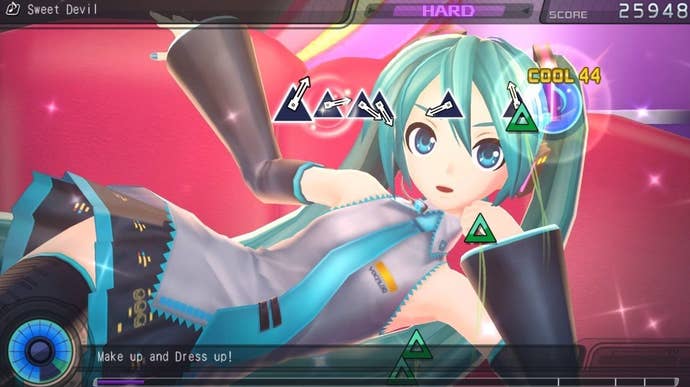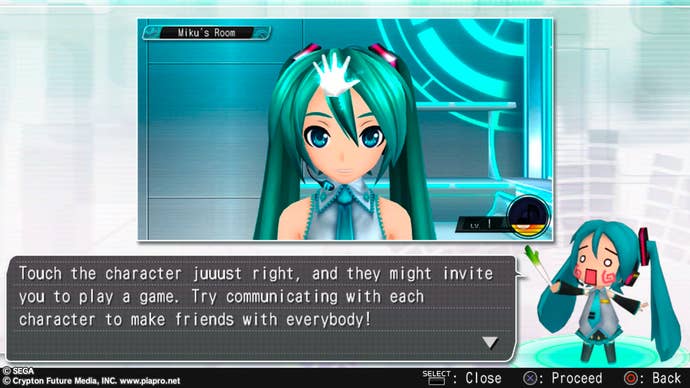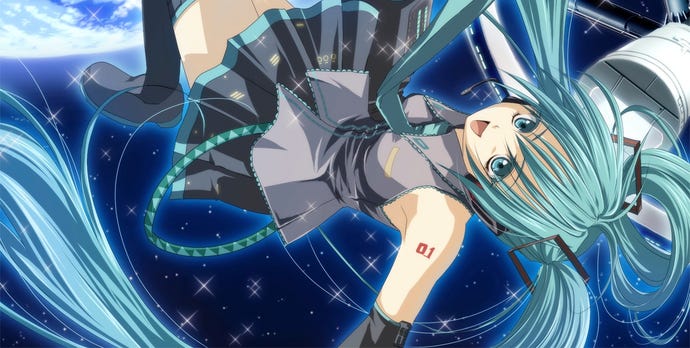JPgamer: Love for the Fans
In this week's exploration of Japanese gaming and game culture, we take a look at the phenomenon of games specifically designed to allow fans to engage and interact with their favorite characters and properties like never before.
This article first appeared on USgamer, a partner publication of VG247. Some content, such as this article, has been migrated to VG247 for posterity after USgamer's closure - but it has not been edited or further vetted by the VG247 team.
Hello again, and welcome to USgamer's regular exploration of Japanese gaming. This week, I'd like to talk about fanservice.
I haven't forgotten the discussion we had in the very first installment of this column, dear reader, in which we talked about how different people had different reactions to Sega's Hatsune Miku Project Diva F game for PlayStation 3, and in which I said I would be specifically addressing the game from my own personal perspective at some point in the future. Since that time, I've been racking my brain trying to think of an appropriate and interesting way to approach the topic that isn't just effectively "re-reviewing" the game, and I think I've finally got it.
Oddly enough, it wasn't Project Diva F itself that inspired today's column, it was Atlus and Aquaplus' fighting game AquaPazza, which I reviewed this week. Playing AquaPazza got me thinking back to Project Diva F, and how these two games -- and others like them -- present a type of interactive experience that is fairly peculiar to Japanese culture.
Specifically, they both represent something that is more than just a pure game intended to be taken in isolation: they're both effectively pieces of merchandise designed to complement particular aspects of culture. In AquaPazza's case, it's something specifically tailored for fans of Aquaplus and Leaf's visual novels to enjoy -- though as I noted in the review, fans of anime in general can get something out of it, too -- and in Project Diva F's case, of course, it's for fans of Crypton Future Media and Yamaha's Vocaloid synthesizer software, and the astonishingly huge culture that has sprung up around the software series' mascot characters Hatsune Miku and friends.
Both games approach the idea of being a "fandisc" in different ways, so let's look at them both individually.

AquaPazza takes the approach of allowing gamers to realize their fantasies of playing as a favorite character in a different context to the norm. Each of the characters on AquaPazza's roster is from either a straight visual novel or a visual novel/RPG hybrid, and as such they've previously been kept somewhat at arm's length from the player in terms of control; AquaPazza allows the player to take direct control over them and then use them to battle against rivals -- or, indeed, completely incongruous characters from a different world. Essentially, it answers that age-old pondering "I wonder what it would be like to play as [character] in a video game?"
There are many ways in which developers can allow players to take full control of a favorite character, but the fighting game genre is by far the most popular means of doing it. Fighting games are inherently designed to have large casts of characters and thus cater to a wide variety of tastes, and in many cases the narrative context of these disparate characters being in the same place isn't questioned. AquaPazza at least attempts to provide a degree of explanation through two different story modes for each character, but ultimately the game is about a series of anime-style characters slapping each other around with various implements. And that's fine; even without the context of the story, each character has a number of iconic moves that accurately reflect their personality and defining characteristics, whether that's a bookish character attacking by dropping bookshelves on people, or the resident "badass masked male" character flinging tigers at his opponent. I don't know Aquaplus' visual novels well since I don't speak Japanese and they've never been officially localized, but I got a good feel for the characters just by seeing how they fight.
AquaPazza is far from the only fighting game based on fanservice of this type, either; the upcoming Dengeki Bunko Fighting Climax features characters from popular anime such as Sword Art Online, Oreimo and Accel World, for example, and while it's a different take on the genre, what is the Super Smash Bros. series if not unashamed, context-free revelling in just how many excellent characters Nintendo has created over the years?

Project Diva F, meanwhile, takes a different approach, and one that is arguably more in keeping with its source material than AquaPazza and other games like it. Hatsune Miku and her friends are represented as virtual pop stars, and thus it makes more sense for them to appear in a music game than anything else. But it's more than just that; it's an opportunity to engage with the Hatsune Miku phenomenon in a variety of different ways -- the actual music game is just part of the whole experience, since the package also allows you to create your own stages and virtual music videos in the terrifyingly comprehensive Edit Mode, dress up Miku and the gang in various costumes and even hang out with them in their (fully customizable, naturally) apartments in Diva Room Mode. There's no obligation to engage in any of this stuff if you don't want to -- Project Diva F's music game is solid enough in its own right -- but if you're deep into the Vocaloid phenomenon, all this combines to make what is essentially the ultimate piece of Miku fan merchandise, and a means through which Miku fans can express themselves by making and sharing their own content, too.
There's an interesting contrast here, too; while AquaPazza encourages you to play as the characters it's paying tribute to, Project Diva F keeps you in the role of yourself, just interacting with the Vocaloids. The Diva Room sequences are presented from a first-person perspective, for example, and you have no direct control over Miku and her friends; they behave how they see fit independently of your input, occasionally responding to things you do such as placing new interactive objects for them to use, or patting them on the head in a gesture of appreciation that will be familiar to anyone who's watched anime in the last few years. Since Miku and her friends are residents of the digital realm rather than real people, Project Diva F presents a means for fans to spend time with their favorite characters that would simply not be possible without video games.
Project Diva F also acknowledges and embraces the fan culture surrounding the Vocaloid characters in two important ways: firstly, by incorporating tunes that are strongly identified with Miku and which became memes in their own right, such as Ievan Polkka (aka "the Leekspin song") and Nyanyanyanyanya! (aka "Nyancat"); and secondly, by complementing every one of its loading screens with a piece of artwork depicting Miku and her friends in various situations. Each picture is clearly the work of a different artist -- presumably drawn from image posting services such as the popular-in-Japan Pixiv -- and the various images, collected together in a gallery when you've seen them at least once, represent the diversity of the Vocaloid fandom through varied visual styles and artistic approaches. It's interesting to see just how many interpretations there are of the different characters -- relatively few of them make use of the "generic anime" style.

AquaPazza and Project Diva F by no means represent the only types of fandisc out there, either. Many visual novels see subsequent fandisc releases that act as side stories, prologues or epilogues to the main plot, for example, which allow players to further immerse themselves in a setting they found particularly compelling, or to spend further time with characters they found particularly appealing. The popularity of the doujinshi movement in Japan, too, means that many independent creators develop spin-off games based on popular characters or franchises, often without official authorization. In short, games are seemingly as important a part of Japanese fan culture as, say, action figures or posters.
The reason I think this is an interesting phenomenon to talk about is because it's something we don't see all that much of for Western properties. Sure, we have video game adaptations of popular movies and TV shows, but it's pretty rare that these are actually any good -- stuff like The Walking Dead and some of the recent Batman games aside -- and it's even rarer we see an interactive adaptation of something that doesn't have a narrative inherently attached, like a musician. When was the last time you saw a Western video game that allowed you to, say, interact with a favorite band or musician in the way you can hang out with Miku and the gang in Project Diva F? (My answer: Spiceworld on PlayStation 1, featuring The Spice Girls. It wasn't pretty.) When was the last time you played a Western game that drew characters from other, disparate and perhaps unrelated games? (Actually, this is something that frequently happens in the indie space, with many titles featuring crossover cameos, but it's still rare to see in the more mainstream sector.) We have plenty of Western fandoms stuffed full of highly creative, talented individuals -- look at the amount of artwork, videos, music and even video games the adult-age My Little Pony fanbase comes out with on a regular basis, for just one example -- so why isn't this side of things embraced more by Western publishers and rights holders?
It's perhaps an interesting indication of the different ways in which Western and Eastern cultures regard interactive entertainment. In Japan, there's a lot of cross-pollination between different types of media: visual novels beget anime and manga adaptations, which beget spin-off games for computer and console, which beget action figures... and so on, in many cases flip-flopping back and forth between several different forms of media before finally coming to a complete conclusion when demand eventually dies down. In the West, meanwhile, we occasionally get books and graphic novels set in the universe of popular video games and, even less frequently, movie adaptations of popular properties, but video games in general are still something that mainstream Western culture seems to struggle to take seriously and integrate wholeheartedly; as much as the new generation of consoles claims to be bringing games and entertainment closer together than ever before, the fact that it's still seemingly necessary to distinguish "games" from "entertainment" is perhaps telling. It's a commonly held argument that there's no real need for mainstream culture to "accept" video games, since they stand perfectly well as their own unique medium, but wouldn't it be more healthy and fun for everyone if games were less fenced-off from the rest of popular culture? Food for thought.
What do you think? Would you like to see more in the way of interactive "fandiscs" for Western things you enjoy, or do you think this is something best left to Japan?
